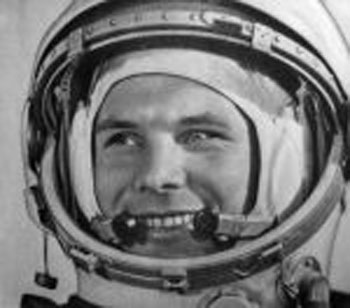I think after the assassination of JFK, it’s the most significant “Where were you when…?” event in our lifetimes. It was the time – as baby-boom teenagers and their parents – we stayed glued to our TV sets all night on July 20, 1969, to watch U.S. astronauts land their Apollo 11 module on the moon and then watched former test pilot Neil Armstrong take those famous steps and speak to the world.
“That’s one small step for a man,” he said. “One giant leap for mankind.”

In truth, however, the race for space began 50 years ago this week when Soviet cosmonaut Yuri Gagarin became the first human being to be catapulted into Earth orbit aboard Vostok 1, a space capsule about as big as the Russian-built Lada.
Of course, little was published about Gagarin’s flight on April 12, 1961, at the time. The U.S.S.R. wasn’t interested in sharing any of its flight data, least of all the inner most thoughts and feelings of its heroic native son. For trivia buffs, however, here are a few details about the first human in orbit I did not know (until I researched it).
Apparently, during the Second World War, when Nazis occupied his town and in fact his house, Gagarin’s family built a mud hut nearby and lived in it for nearly two years (maybe that helped him relate to living in a confined space).
Among the reasons Gagarin was chosen for the first orbit, according to his air force doctor: He was modest, had a terrific memory and was embarrassed when his humour got too racy. Did you know that Yuri was a pretty fair ice hockey goaltender? And he wasn’t afraid to speak his mind; although his family observed Christmas and he baptized his daughter just before the flight, he had one notable comment on his return from space.
“I don’t see any God up here,” he reported.
A few years later, the village in which he was born was renamed Gagarin in his honour. When he and a fellow jet flight instructor died in a crash in March 1968, his body was cremated and the ashes encased in the walls of the Kremlin on Red Square in Moscow. Not surprisingly, an entire community has sprung up around the theory that conspirators planned the jet crash.
Speaking of conspiracies, one of my favourite pieces of outer space junk, as it were, was a movie released in 1978. “Capricorn One” is the fictional account of a manned mission to Mars. Indeed, the rocket is sitting on the launch pad in its final countdown, when its three astronauts are suddenly extricated from the ship, hustled into a waiting jet and locked in an army base in the desert.
As the rocket is launched empty, its crew is forced to act out the trip to and landing on Mars in a Hollywood set inside the isolated base. You see, flight officials have discovered a problem with the ship’s life-support system would kill the crew part way through the mission. And NASA can’t afford that. So it blackmails the crew into simulating the successful trip in the desert warehouse.
But my favourite part of the movie has nothing to do with either the plot or the space conspiracy theories that abounded after that (i.e. that Armstrong and the boys never really got to the moon, that Apollo 13 was sabotaged, etc.) I loved the movie for its use of a wonderful old shaggy-dog story that actor James Brolin tells out loud while climbing a cliff face in the desert heat; it’s about a favourite cat, its owner and his mother (I’ll tell you the whole story another time). But I can’t think of the movie and not the joke whenever anybody says:
“Have you heard the latest conspiracy about outer space travel?”
Now, as odd as it might seem, this country has plenty of space tradition in its own backyard. Canada – from the first Telesat satellite in 1970, to the Spar Aerospace innovation “Canadarm,” and such luminary astronauts as Marc Garneau, Roberta Bondar and Bjarni Tryggvason – has contributed greatly to humankind’s reach for the stars. But remarkably one of Canada’s greatest space thinkers got his start about the same time as Yuri Gagarin. His name was Gerald Bull, a doctor of science at McGill.
“Why use rockets?” Dr. Bull asked in the early ’60s.
And he proceeded to design what amounted to a high-powered gun. His team – the High Altitude Research Project (HARP) – fired a 460-pound vehicle from a 16-inch naval gun in Barbados. It soared to 80,000 feet and gathered the first data about the Earth’s ionosphere. But Bull’s lofty dream was grounded by a Canadian nemesis – insufficient funds.
Like Gagarin, Canada has proved capable on the ice and in space.